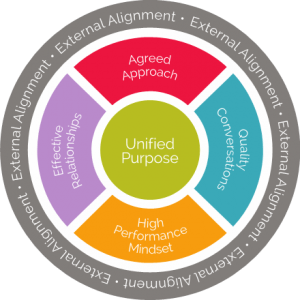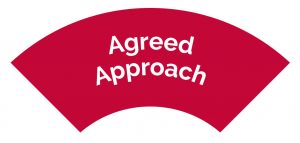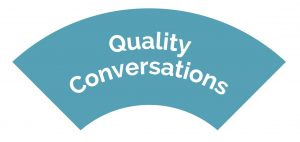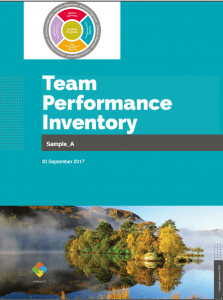 Teams always need help. Even teams that are gifted, focused and high-functioning (and there are precious few of these) tend to run into the same challenges and face the same tensions time and time again. Within the voice and structure of OKA’s newest team tool, the TPI (Team Performance Inventory), here are three team tips that we at OKA use and try to activate with great frequency.
Teams always need help. Even teams that are gifted, focused and high-functioning (and there are precious few of these) tend to run into the same challenges and face the same tensions time and time again. Within the voice and structure of OKA’s newest team tool, the TPI (Team Performance Inventory), here are three team tips that we at OKA use and try to activate with great frequency.
#1: Know and agree upon why you exist
Why is your team around? What are your goals and intended outcomes? What are the tasks or reasons at the center of your team’s work?
 Surprisingly, many teams can’t respond to these questions with consistent, shared answers. Effective teams need a shared focus—the TPI calls this a Unified Purpose. Unified Purpose represents why the team exists. This part of the Team Performance Inventory reflects the degree to which team members understand and then consciously and collectively act towards the same agreed goals and outcomes. Without Unified Purpose, a team will have no center of gravity to bind its members and their work together, and as a result, members splinter, drift apart and work to different ends.
Surprisingly, many teams can’t respond to these questions with consistent, shared answers. Effective teams need a shared focus—the TPI calls this a Unified Purpose. Unified Purpose represents why the team exists. This part of the Team Performance Inventory reflects the degree to which team members understand and then consciously and collectively act towards the same agreed goals and outcomes. Without Unified Purpose, a team will have no center of gravity to bind its members and their work together, and as a result, members splinter, drift apart and work to different ends.
Unified Purpose Action (for teams lacking this shared focus):
Have everyone on the team without talking to or sharing with anyone else write down the purpose of the group/team from his/her perspective and understanding. Once everyone has written the team’s purpose from his/her understanding, each team member shares his/her written purpose until everyone’s ideas have been shared. Discuss the differences or contrasting ideas until one written statement could serve as the team’s Unified Purpose.
#2: Know what each other does and how your collective goal(s) will be achieved
How does your team do its work? What tasks and responsibilities does each group member have or perform? What are your procedures—regarding both task and interpersonal engagement? What habits and traditions do you have?
 Teams can have a Unified Purpose, but still get derailed by lacking a shared process for how their work gets done. Within the Team Performance Inventory, Agreed Approach represents the team’s conscious recognition and collective ascent to established group processes like communication, problem solving, decision making, and generative thinking. An Agreed Approach reflects a team’s alignment regarding the way its work is to be done.
Teams can have a Unified Purpose, but still get derailed by lacking a shared process for how their work gets done. Within the Team Performance Inventory, Agreed Approach represents the team’s conscious recognition and collective ascent to established group processes like communication, problem solving, decision making, and generative thinking. An Agreed Approach reflects a team’s alignment regarding the way its work is to be done.
Agreed Approach Action (for teams struggling with common procedures or methods or working together):
- Team members each write his/her duties on Post-it notes—one duty or job activity per note—and stack the Post-it notes. The point is to capture the duties—even those done only sporadically or occasionally, NOT for any one team member to come up with more than anyone else. There is not a prize for “most duties.”
- Team members then take turns (1-3 minutes per person) posting his/her duty notes onto a wall or flip chart. Team members can ask clarifying questions if needed, but this is not a debate—the goal is for everyone to catalog and share his/her collection of duties.
- When everyone’s duties are posted, team members should discuss:
- What surprises are there?
- Any areas of overlap—are multiple people doing the same task unnecessarily?
- Any gaps—are there tasks needing attention no one has picked up?
- Alignment with Unified Purpose—are there tasks that don’t seem related to the group/team’s core focus?
#3: Try to trust and like each other, but whether you do or not, communicate with care and respect
What actions do team members take to overtly engage each other? Do team members openly question and actively listen to each other? Is diversity—of all kinds—acknowledged and embraced on the team?
 Teams work best when there is genuine care and concern held and exercised by its members for each other. Trust, openness, and genuine affection—if these are at the core of a team, the group has a much better chance for success. The TPI defines this as Effective Relationships, and as important and powerful as this can be, it is important that teams not get these genuine feelings confused with how members actually treat and interact with each other. For whether they like each other or not, group members need to communicate effectively and treat each other with respect. The TPI refers to this as Quality Conversations.
Teams work best when there is genuine care and concern held and exercised by its members for each other. Trust, openness, and genuine affection—if these are at the core of a team, the group has a much better chance for success. The TPI defines this as Effective Relationships, and as important and powerful as this can be, it is important that teams not get these genuine feelings confused with how members actually treat and interact with each other. For whether they like each other or not, group members need to communicate effectively and treat each other with respect. The TPI refers to this as Quality Conversations.
 Quality Conversations are the ways in which team members communicate, particularly in terms of sharing and building on each other’s ideas. Quality Conversations reflect the degree to which team members act in good faith on behalf of team diversity, relationships, and a mutual respect for individual team members. Quality Conversations and Effective Relationships are related, but they are not the same thing. And it is possible—it happens often—to have a team that is actively engaged with one and not the other.
Quality Conversations are the ways in which team members communicate, particularly in terms of sharing and building on each other’s ideas. Quality Conversations reflect the degree to which team members act in good faith on behalf of team diversity, relationships, and a mutual respect for individual team members. Quality Conversations and Effective Relationships are related, but they are not the same thing. And it is possible—it happens often—to have a team that is actively engaged with one and not the other.
Effective Relationships Actions (for teams that needs more trust and openness):
- Compliment a team member—and mean it—on a quality he/she embodies or an accomplishment he/she has achieved.
- Ask someone for help with a challenge or problem that faces you.
Quality Conversations Action (for teams that need practice in communicating effectively with each other):
- Practice echoing and summarizing team mates in discussion—especially when talking about differing points of view or contentious topics. Take the time to summarize and repeat someone else’s viewpoint or suggestion until the other person agrees that you have captured the thought/statement in both content and spirit. This does not mean you agree, but it does show that you have listened and really taken in and considered another point of view.
The TPI—OKA’s newest and most unique team tool
 The Team Performance Inventory (TPI) is an exciting new tool that allows a team or group’s members to answer questions about the team as a whole on a range of six domains critical to team success—Unified Purpose, External Alignment, Quality Conversations, Effective Relationships, Agreed Approach, and High Performance Mindset. Team members’ data—both numerical and open-ended responses—are tallied and compiled to produce a data-rich profile of the team, its likely talents, and its challenges. The TPI report even helps guide a team toward developmental next steps with suggested activities and a team action plan.
The Team Performance Inventory (TPI) is an exciting new tool that allows a team or group’s members to answer questions about the team as a whole on a range of six domains critical to team success—Unified Purpose, External Alignment, Quality Conversations, Effective Relationships, Agreed Approach, and High Performance Mindset. Team members’ data—both numerical and open-ended responses—are tallied and compiled to produce a data-rich profile of the team, its likely talents, and its challenges. The TPI report even helps guide a team toward developmental next steps with suggested activities and a team action plan.
Click here to learn more about the Team Performance Model—the model at the core of the Team Performance Inventory (TPI).
To learn more about the TPI or OKA’s one-day TPI certification workshops, visit OKA online.

Leave a Comment